This week's blog post places the spotlight on Phoenix Dan Cong, a Chinese Oolong that we have recently started to stock. Phoenix Dan Cong which is also known as Fenghuang, is a produced at Phoenix Mountain in Guangdong Province, China. Phoenix Dan Cong is not as well known as Wuyi Oolong tea, which you can read about here, though it does share a lot of similarities. Phoenix Dan Cong is typically produced in two styles, Classic and Bouquet. Classic style is the particular cultivar that we stock and which we will focus on in this blog. The classic style of Phoenix Dan Cong is usually distinguished with a pleasant aroma of sweet fruits, honey, toasted notes and some floral undertones. When infused it produces a dark golden liquor which has a smooth, creamy mouth feel with a slight touch of astringency. Depending on the variety, you may get accents of roasted cocoa, orange peel or almonds. The Classic style is different from the bouquet style mainly through longer fermentation and a longer baking. The quality of the baking process has a major influence on the final taste of the tea; if it is over-baked it can have an undesirable burnt taste. Tea that is picked from the current harvest is often lightly baked which gives the tea a smooth freshness while older harvests can be re-baked to give the tea a more mature flavour.
Dan Cong
The term Dan Cong means "single bush" because each of the Phoenix Dan Cong tea plants are allowed to grow as wild bushes. Some of these tea plants have been allowed to grow up to 5 meters high. This is a very different method of tea cultivation than that of garden teas, which are arranged in hedges and frequently maintained to make the tea leaves easier to pluck. Based on this definition the term Dan Cong should not only be applied to Phoenix Dan Cong but also to Wuyi Oolong and also some varieties of Pu-erh. The Phoneix Dan Cong that is produced from these aged wild tea plants has a very different taste from the Phoenix Oolong garden teas, with a much fuller body and a long-lasting aftertaste.
Processing
Withering
After the harvest, the fresh tea leaves are brought back to the factory and are spread out on bamboo mats. The bamboo mats are moved outside and the tea is left to wither naturally under the afternoon sun, usually about 4 to 5 o'clock. The leaves are withered for a period of time which is determined by the tea master, depending on the water content of the tea leaves and also the atmospheric conditions. To determine if the withering process is complete there are some signs that the tea masters look for; the buds begin to bend down, the leaves soften and produce a fresh aroma and the leaves darken as a result of losing moisture. To complete the withering process, the leaves are placed either indoors or in a shady place to cool. This allows the withering process to continue at a slower rate and under cooler conditions.
Oxidization
This is the most important part of the process when making Phoenix Dan Cong. The tea leaves are placed in bamboo baskets and shaken several times, bruising the tea leaves and allowing the oxidization process to occur. After the leaves have been shaken they are then allowed to rest for around two hours before this stage is repeated. This can be repeated up to 8 times and towards the end of the process the leaves are often placed into rolling drums and rotated for 10-15 minutes. The tea masters inspect the degree of oxidation based upon the change of flavour, aroma, shape and colour of the leaves. The aroma of the leaves changes significantly throughout this stage, the first and second cycles give the leaves a fresh and grassy aroma, whilst the later 7-8 cycles give a fruity and floral aroma.
Pan Firing
The pan-firing stage is used to stop the oxidation and stabilise the flavour and character of the tea leaves. The tea leaves are placed in pans at a high temperature for about 5 minutes. They are then removed from the pan and shaped, usually by hand through a rolling process. They are then returned to the pan at a slightly cooler temperature which softens the leaves and gives off a strong aroma. When the tea master is satisfied with the tea leaves he removes them from the pan and allows places them on bamboo trays which are heated by charcoal. This usually occurs over two stages using different temperatures of baskets, and for different lengths of time.







